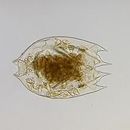en
names in breadcrumbs


Swimming activity of this species is performed by the coordinated beat of the cingulum cilia, and is controlled by two innerved muscles inserted on the infraciliature. Rotifers such as Brachionus calyciflorus are favored test animals in aquatic toxicology because of their sensitivity to most toxicants. It is one of the live food organisms used for the mass production of larval fish. The selection of this species for toxicological studies is ecologically well justified as this species is not only very abundant and plays a major role in several ecological processes in freshwater communities, but also has a cosmopolitan distribution. It feeds micro-algae and is a very euryhaline and ubiquitous species.
Lorica saccate, rather flexible, very weakly flattened dorso-ventrally, smooth. Antero-dorsal lorica margin with four spines with broad base, pointed, length variable, usually long, equal in length or median pair longest; posterior spines present or absent; with or without postero-median spines at foot opening. Trophi with all characteristics of the genus. A very polymorphous species, with many variants described.
The taxonomy of B. calyciflorus is particularly confused. Validation of the numerous proposed subspecies and infrasubspecific variants awaits a thorough revision of the taxon. Thus, B. calyciflorus is a very variable species.
The first time it was mentioned by Pallas (1766), but he did not indicated the locality where collected this species. Brachionus calyflorus is common everywhere in all regions of the world.
Planktonic in fresh and brackish waters
Lorica length 200‒600 µm, median antero-dorsal spines 25‒200 µm, lateral antero-dorsal spines 15‒95 µm, postero-lateral spines up to 300 µm, postero-median spines up to 120 µm.